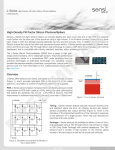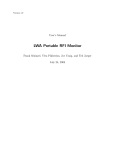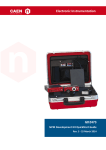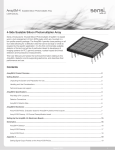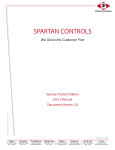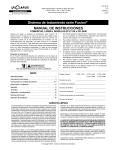Download Overview R-Series: Low Noise, Fast, Red-Sensitive Silicon
Transcript
R-Series Low Noise, Red-Sensitive Silicon Photomultipliers USER MANUAL IN A R Y R-Series: Low Noise, Fast, Red-Sensitive Silicon Photomultipliers The R-Series is a new family of Silicon Photomultiplier (SiPM) sensors providing sensitivity into the red and NIR portion of the electromagnetic spectrum. The R-Series SiPM sensors feature high responsivity, fast signal response, and a low temperature coefficient of operating voltage, all achieved at a bias of ~30V. The sensor is packaged in a compact and robust MLP package that is suitable for reflow solder processes. Both the sensor and the package are designed for volume production, with the product delivered on tape and reel. This User Manual covers all aspects of using and understanding the R-Series range of sensors and evaluation boards. More details on the performance characteristics of the R-Series sensors can be found in the R-Series datasheet. Overview R-Series M The R-Series SiPM sensors from SensL are based on an N-on-P diode structure (Figure 1) and have a different pin-out, pulse polarity and bias voltage compared to SensL P-on-N sensors i.e. C-Series and J-Series. Please consult the R-Series pin-out that is given on page 7, and the datasheet for the correct bias voltage. Some notable features of the R-Series are as follows: P R E LI Responsivity: R-Series sensors feature high-density microcells, which in conjunction with the sensors high gain yield impressive responsivity values, even at 905nm (530 kA/W). Figure 2, Simplified microcell level schematic of the R-Series SiPM. Figure 1, N-on-P sensor structure. Timing: R-Series sensors feature optimized quench resistor values, and other improvements that have dramatically reduced the microcell recovery time and the standard signal rise time. All R-Series sensors also feature SensL’s proprietary fast output terminal (Figure 2), which is the derivative of the internal fast switching of the microcell in response to the detection of a single photon, and has sub-nanosecond rise times and pulse-widths. These features make the R-Series sensors highly suited to high-performance timing applications. Package: The R-Series sensors are packaged in a low-cost, highly robust, surface mount MLP (micro leadframe) package. It has been designed for volume applications and is available on tape and reel and compatible with industry-standard reflow soldering processes. The R-Series sensors are also available pre-mounted on a small PCB evaluation board, allowing for easy access to the fast output, anode and cathode via SMA connectors. SensL © 2015 1 R-Series Low Noise, Red-Sensitive Silicon Photomultipliers USER MANUAL Contents IN A R Y Overview...................................................................................................................................................... 1 Biasing and Readout.................................................................................................................................... 3 Fast Mode Biasing and Readout of MicroFR Sensors.......................................................................... 3 Recommended Fast Mode Readout........................................................................................... 3 Fast Output Amplification............................................................................................................ 3 Recommended Fast Mode Biasing............................................................................................. 3 Standard Mode Biasing and Readout of R-Series Sensors.................................................................. 5 Recommended Standard Mode Biasing...................................................................................... 5 Recommended Standard Mode Readout and Amplification........................................................ 5 R-Series Evaluation Board (MicroFR-SMA).................................................................................................... 6 Schematics, Pin/Pad Identification and Solder Footprint............................................................................... 7 M MicroFR 10000 Series MLP Package.................................................................................................. 7 MicroFR-SMA-100XX Board................................................................................................................ 8 Handling and Soldering................................................................................................................................ 9 LI Safe Handling of Sensors.................................................................................................................... 9 Delivery Options................................................................................................................................... 9 MLP Package...................................................................................................................................... 10 ‘Not Connected’ (NC) Pads and Pins................................................................................................... 11 R E Further Help................................................................................................................................................. 12 P Appendix A - Biasing Alternatives & Signal Polarity....................................................................................... 13 SensL © 2015 2 R-Series Low Noise, Red-Sensitive Silicon Photomultipliers USER MANUAL Biasing and Readout IN A R Y Y Fast Mode Biasing and Readout of MicroFR Sensors Recommended Fast Mode Biasing The fast output is referenced to the anode (substrate) of the SiPM. Therefore the use of a positive bias voltage applied to the cathode with the anode at 0 V is recommended, as in Figure 3. The fast mode signal polarity is negative, and AC coupled, with no DC component. The observed signals will be very fast, with rise-times ~300ps and pulse widths <1ns. Please refer to the R-Series datasheet for the operating bias to use. Figure 3, Recommended biasing For all application circuits shown in this User Manual, it is recommended that bias voltage decoupling, such as the one shown in Figure 4, is used. SensL do not recommend the use of a negative bias because it can cause degradation of the signal from the fast output. If an application requires the use of a negative bias, please refer to the advice in Appendix A, and specifically, schematic ‘B’. Recommended Fast Mode Readout LI Fast Output Amplification M Due to the extreme speed of the signals from the fast output, care should be taken in the routing of the signal. Common microwave/RF design rules, such as controlled impedance microstrip lines, should be used. The capacitance of the fast output electrode is much lower (of the order of 2-3pF for a 1mm device) than that from the standard output. The lower output capacitance does not typically allow the use of a transimpedance amplifier, and instead one can use an RF style (50W impedance) solution including direct connection to a coaxial cable. R E It is important to note that the signal charge injected into the fast output electrode is typically about 2% of the SiPM charge generated during the avalanche. However, the pulse duration is approximately 100 times shorter, so the current amplitude observed is about 0.02*100 = 2 times higher. This high current amplitude, in combination with the significantly lower output capacitance, make the device suitable for photon counting at very high speed (tens of MHz and higher has been demonstrated in the lab). P For amplification of the fast signal it is recommended that a low noise 50W RF amplifier be used. As with standard readout, the level of gain required is dependent on the application. For applications with high photon counts it is recommended that the Mini-Circuits ZX60-43S+ be used. For photon counting applications it is recommended that the Mini-Circuits ZFL-1000LN+ be used. SensL © 2015 3 R-Series Low Noise, Red-Sensitive Silicon Photomultipliers IN A R Y USER MANUAL P R E LI M Figure 4, Generic bias decoupling, for positive (left) and negative (right) biasing configurations, recommended for all circuits given in this User Manual. SensL © 2015 4 Low Noise, Red-Sensitive Silicon Photomultipliers USER MANUAL Standard Mode Biasing and Readout of R-Series Sensors Recommended Standard Mode Biasing IN A R Y SensL’s R-Series sensors can also be used in the conventional manner, using the anode and cathode, and leaving the fast output unconnected. SensL refer to this as standard mode. In this case, the fast output terminal can be left open with no detriment to its standard mode performance. Standard mode signals may be more suitable for applications involving slow pulses or slowly-varying, continuous light levels, such as in luminometers or for gammaray spectroscopy with slow or low-light scintillators. Standard mode can also benefit applications that can take full advantage of the high gain of the SiPM to reduce the gain requirements of subsequent gain stages. M Figure 5 below shows the standard mode biasing configuration. For MicroFR sensors the fast output electrode is left open (unconnected). For all R-Series sensors read out in standard mode, the cathode should be held at a positive bias with reference to the anode. It is recommended that the signal is taken from the side of the sensor held at 0V. Reading out in this way yields a pulse that has a rise time of ~1ns and a decay time constant of between 10ns 50ns, depending on microcell size. Various biasing schemes are discussed in Appendix A. Figure 5, Biasing for standard mode. The cathode should be positive with respect to the anode, but either a positive or negative bias can be used. R E LI When the fast output is not in use it should be left floating. Do not connect it to ground or have any wires or cables connected to it. Recommended Standard Mode Readout and Amplification Figure 6 shows how the R-Series devices can be connected to a standard high speed amplifier, such as the OPA656, to convert the standard mode output signal current to a voltage. This technique is recommended for standard mode readout of all SensL SiPM devices. The fast output should be left open. P Y R-Series Figure 6, Example readout circuit for standard mode. If the fast output is used, place a 100nF from anode to 0V. +Vbias should be decoupled, as in Figure 4. SensL © 2015 5 R-Series Low Noise, Red-Sensitive Silicon Photomultipliers USER MANUAL R-Series Evaluation Board (MicroFR-SMA) IN A R Y The R-Series sensors are available ready-mounted on test boards, to allow for easy evaluation. The MicroFR-SMA100XX product line (Figure 7) features an R-Series MLP-packaged SiPM sensor (type specified by the 100XX digits) soldered onto a small PCB board. The board is simple to use, having just three SMA (female) connectors: one delivers the bias voltage (Vbias) and the other two provide the output signals: standard output from the cathode (Sout) and the fast output (Fout). The SMA board requires a negative bias, which allows the standard output to be referenced to ground rather than the bias. The circuit on the SMA board is as in example ‘B’ of Appendix A, along with the decoupling circuit of Figure 4. Fast output Bias SMT sensor M Mounting holes Standard output LI Figure 7, The MicroFR-SMA board Output Vbias Fout Standard female SMA connector R E Sout Connector Function bias input (anode) fast output standard output (cathode) Comments negative bias if unused can be left open if unused can be left open Table 1, SMA Connections P The MicroFR-SMA is recommended for users who require a plug-and-play set-up to quickly evaluate R-Series sensors with optimal timing performance. The board provides outputs which can be connected directly to the oscilloscope or measurement device. The board also allows the standard output from the cathode to be observed at the same time as the fast output. Table 1 summarizes the connections to the SMA board. Each board has two mounting holes to allow secure placement during testing, with sensors located at the edge of the board. This allows two sensors to be placed in close proximity for coincidence timing measurements. The schematics showing the dimensions of the SMA board are on page 8. SensL © 2015 6 R-Series Low Noise, Red-Sensitive Silicon Photomultipliers USER MANUAL Schematics, Pin/Pad Identification and Solder Footprint Pin Assignments 1 Cathode (N) 2 Fast Output 3 Anode (P) 4 No Connect * M R-Series LI * Pin # IN A R Y Y MicroFR 10000 Series MLP Package P R E No Contact (NC) pin 4 should be soldered to PCB, this pin can be connected to ground but it can also be left floating without affecting the dark noise. Figure 8, Solder footprint for the MicroFR-100XX-MLP part. All dimensions in mm. SensL © 2015 7 R-Series Low Noise, Red-Sensitive Silicon Photomultipliers USER MANUAL P R E LI M See Table 1 for SMA connections. IN A R Y MicroFR-SMA-100XX Board SensL © 2015 8 Low Noise, Red-Sensitive Silicon Photomultipliers USER MANUAL Handling and Soldering IN A R Y Safe Handling of Sensors • When unpacking, care should be taken to prevent dropping or misorienting the sensors. The specific items contained in the package and the type of packaging will depend on the parts ordered. • Remember that the SiPM is a sensitive optoelectronic instrument; always handle the sensor as carefully as possible. • The sensor should be disconnected from the bias supply when not in use. • SiPM sensors are ESD sensitive. The following precautions are recommended: • Ensure that personal grounding, environmental controls and work surfaces are compliant with recommendations in JESD625. • Ensure that all personnel handling these devices are trained according to the recommendations in JESD625. M • Devices must be placed in an ESD approved carrier during transport through an uncontrolled area. Delivery Options LI Table 2 summarizes the delivery options. In the following sections, handling and soldering advice is given for each package type. Delivery option MSL* Reflow Solder? TR (Tape & Reel) 3 Y SMT - Cut Tape TA (Cut Tape) 4 Y SMT - Other WP (Waffle pack), GP (Gel pack) N/A Y** R E Package type SMT - Tape & Reel Table 2, Summary of which package types are associated with which product type. * See Table 3 for definition P Y R-Series ** Sensors shipped in either a waffle pack (WP) or gel pack (GP) require a bake according to J-STD-20, prior to reflow soldering SensL © 2015 9 R-Series Low Noise, Red-Sensitive Silicon Photomultipliers USER MANUAL MLP Package A dedicated SMT Handling and Soldering Tech Note is available that contains in depth information on the storage and use of the MLP parts, including the CAD for the tape and reels. R Y The MLP package is compatible with standard reflow solder processes (J-STD-20) and so is ideal for high volume manufacturing. The recommended solder footprint is shown with the schematics on page 7. If the MLP part is being assembled into an array, the advice in the SMT Array Tech Note should be followed. IN A MLP SiPM sensors are shipped in moisture barrier bags (MBB) according to the J-STD 033 standard. An unopened MBB should be stored at a temperature below 40OC with humidity below 90%RH. After the MBB has been opened, the devices must be reflow soldered within a period of time depending on the moisture sensitivity level (MSL). SensL MLP Tape & Reel are MSL 3, cut tape MLP are MSL 4 and MLP sensors shipped in trays require a bake prior to reflow soldering. See Table 3 for details. MSL Exposure time Condition 3 4 168 hours 72 hours ≤30 °C/60% RH ≤30 °C/60% RH Applicable MLP shipping format Tape and reel Cut tape and partial reels Table 3, MSL definitions applicable to SensL MLP products (reference J-STD 020). LI M All MLP shipped on tray do not have an MSL rating and should be baked prior to placement on PCB. Please discuss this with your contract manufacture for their recommended baking cycle which adheres to IPC/JEDEC J-STD-20 MSL Classification. Note the temperature of the bake should not exceed the recommended operating temperature of the product listed in product’s datasheet. E Exposure to solvents such as concentrated isopropyl alcohol (propan-2-ol) or commercial flux removal fluids such as Fluxene will cause severe, irreversible damage to the MLP packages. If cleaning is necessary, a 20% solution of isopropyl alcohol can be used. Further details on cleaning can be found in the SMT Handling Guide. ‘Not Connected’ (NC) Pads and Pins P R Common PCB design practice is to ground any floating pins or pads such as those labelled ‘NC’. Grounding the pin helps shielding and can reduce noise interference from external sources (EMI/RF). SensL © 2015 10 Low Noise, Red-Sensitive Silicon Photomultipliers USER MANUAL Further Help IN A R Y If more help is required in the set-up or operation of R-Series sensors, there are several SensL resources that can help. • The R-Series Datasheet contains more detailed information on the physical and performance characteristics of the sensors. • A variety of Tech Notes are available on the website, www.sensl.com, such as: • A guide to handling and soldering SMT packages. • A guide on creating arrays of close-packed SMT sensors. • An extensive library of technical and scientific papers on the use of SensL SiPM sensors. R E LI M • If additional help is needed, please contact [email protected] P Y R-Series SensL © 2015 11 R-Series Low Noise, Red-Sensitive Silicon Photomultipliers USER MANUAL Appendix A - Biasing Alternatives & Signal Polarity R Y This Appendix lists all of the possible ways in which a R-Series SiPM can be biased. Not all of them will deliver optimum performance but are included for completeness. For each biasing arrangement, the standard and fast signal polarities are given. The following abbreviations are used throughout: Vbias = bias voltage Sout = standard output Fout = fast output Rs = load resistor for the standard output Vs = standard output voltage Vf = fast output voltage IN A Rf = load resistor for the fast output RQ = quench resistor (included on the SiPM die) A When using one of the MicroFR products in fast mode, it is recommended to use biasing scheme A, as shown on the left. M This configuration will give the best timing performance and if fast output only is required then the resistor Rs can be zero ohms or +Vbias can be applied directly to the SiPM cathode. P R E LI Note that there will be a positive offset on the Sout signal in this configuration as the pulse is referenced to +Vbias. A DC blocking capacitor could be used to block the bias. B Alternatively, a negative bias can be applied to the anode (substrate), as shown in B on the left. However, care must be taken to ensure good decoupling of the bias voltage at the device since the substrate is the return path for the fast signal. If this biasing configuration is required, it is recommended that a 10nF (50V) ceramic SMT decoupling capacitor with low ESR is placed as close to the cathode as possible. Without suitable decoupling the fast output pulse can suffer from ringing and pulse shape distortion when the negatively biased anode configuration is used. An advantage of this configuration over configuration A is that the standard output is now referenced to 0V potential. However if the standard output is not required then the resistor Rs can again be made zero ohms or the SiPM anode connected directly to 0V. SensL © 2015 12 R-Series Low Noise, Red-Sensitive Silicon Photomultipliers USER MANUAL IN A R Y D Y C P R E LI M Neither of the biasing schemes represented in C or D are recommended for use with high precision timing applications on the standard or in particular the fast output as these schemes would require the cathode or the substrate of the SiPM chip to be switched. However, either would be suitable for applications where the pulse timing is not critical. www.sensl.com [email protected] +353 21 240 7110 (International) +1 650 641 3278 (North America) All specifications are subject to change without notice Rev. 1.0, November 2015 SensL SensL©©2015 2015 13
















